Attention to Face as a Predictor of Developmental Change and Treatment Outcome in Young Children with Autism Spectrum Disorder
Abstract
:1. Introduction
2. Materials and Methods
2.1. Participants
2.1.1. The Context of the Current Study
2.1.2. Cross-Sectional Sample
2.1.3. Unstructured Longitudinal Sample
2.2. Measures
2.3. Procedure and Stimulus
2.4. Analysis Strategy
2.4.1. Eye-Tracking Data Analysis
2.4.2. Statistical Analyses
- Reduced group effect model:
- Reduced slope model:
3. Results
3.1. Group Differences at Baseline
3.2. Cross-Sectional Results
Attention to Face and Clinical Characteristics
3.3. Longitudinal Analyses
3.3.1. Attention to Face as a Predictor of Developmental Change over Time
3.3.2. Attention to Face as a Predictor of Treatment Outcome
4. Discussion
5. Conclusions
Author Contributions
Funding
Institutional Review Board Statement
Informed Consent Statement
Data Availability Statement
Acknowledgments
Conflicts of Interest
Appendix A. Attention to Face as a Predictor of Developmental Change over Time

Appendix B. Attention to Face as a Predictor of Treatment Outcome

Appendix C
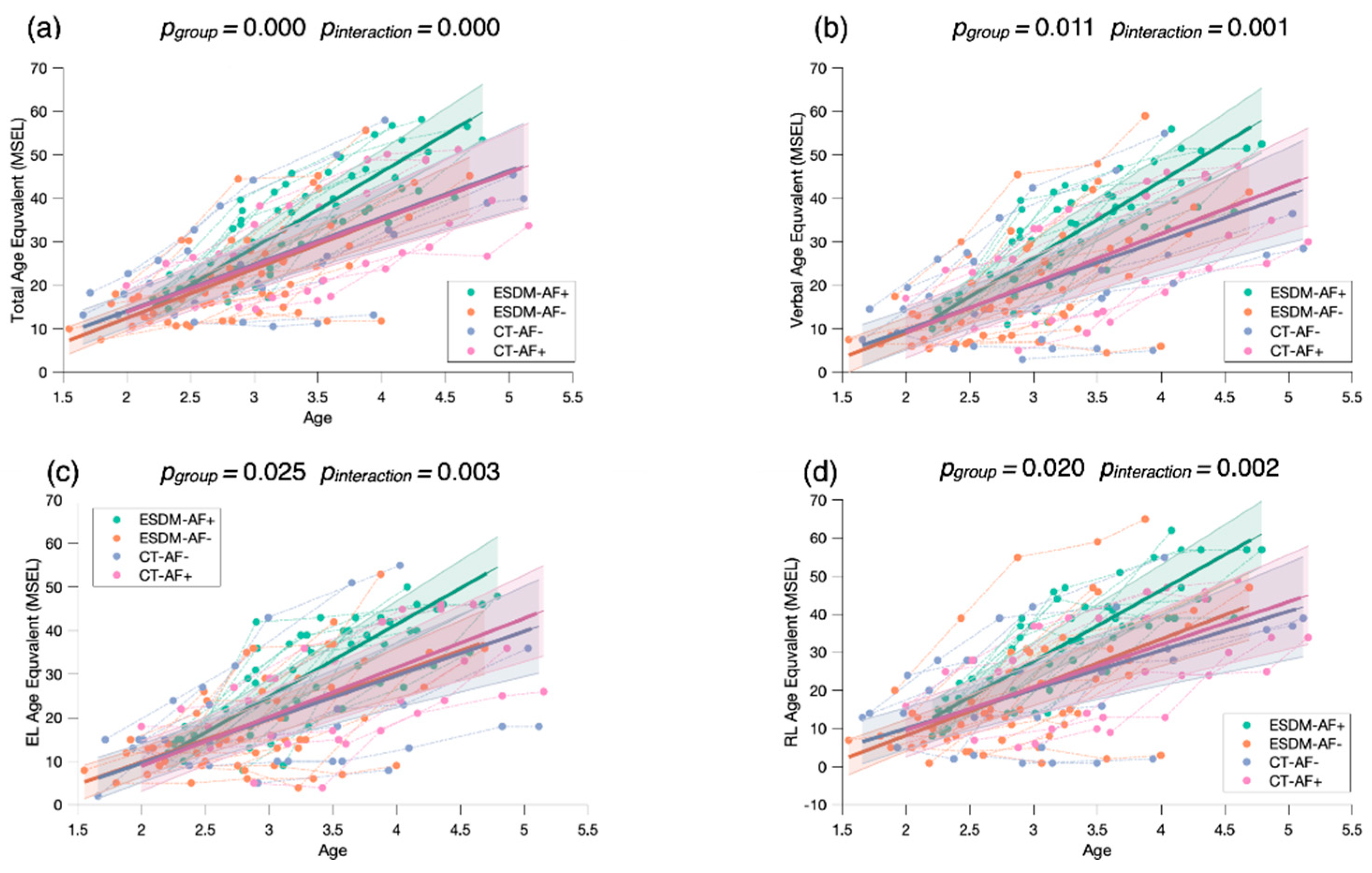
Appendix D

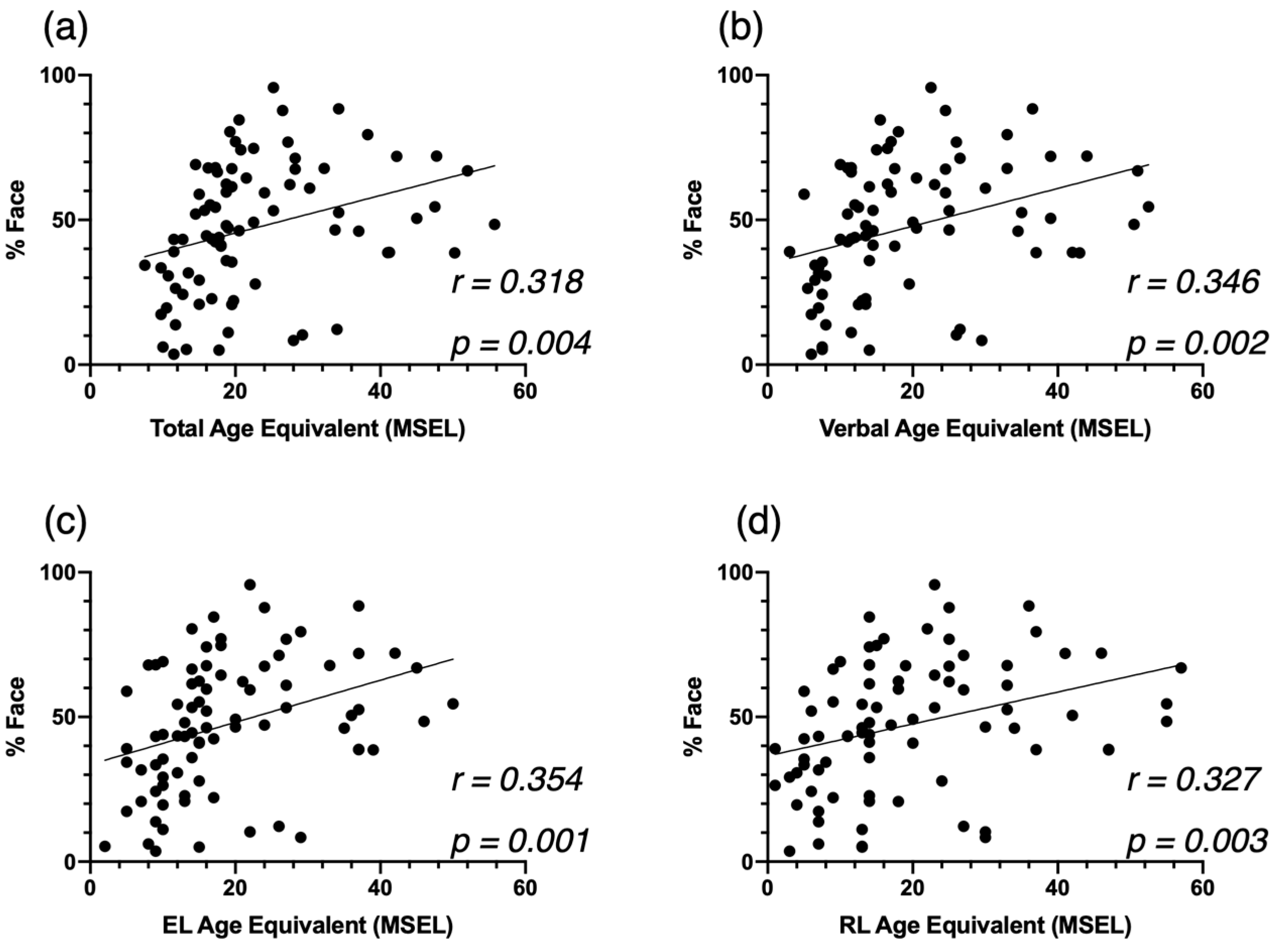



References
- American Psychiatric Association (APA). Diagnostic and Statistical Manual of Mental Disorders, 5th ed.; American Psychiatric Publishing: Arlington, VA, USA, 2013; ISBN 978-0-89042-554-1. [Google Scholar]
- Zwaigenbaum, L.; Bryson, S.; Rogers, T.; Roberts, W.; Brian, J.; Szatmari, P. Behavioral manifestations of autism in the first year of life. Int. J. Dev. Neurosci. 2005, 23, 143–152. [Google Scholar] [CrossRef]
- Perin, C.; Valagussa, G.; Mazzucchelli, M.; Gariboldi, V.; Cerri, C.G.; Meroni, R.; Grossi, E.; Cornaggia, C.M.; Menant, J.; Piscitelli, D. Physiological Profile Assessment of Posture in Children and Adolescents with Autism Spectrum Disorder and Typically Developing Peers. Brain Sci. 2020, 10, 681. [Google Scholar] [CrossRef]
- Elsabbagh, M.; Fernandes, J.; Jane Webb, S.; Dawson, G.; Charman, T.; Johnson, M.H. Disengagement of Visual Attention in Infancy is Associated with Emerging Autism in Toddlerhood. Biol. Psychiatry 2013, 74, 189–194. [Google Scholar] [CrossRef] [Green Version]
- Pierce, K.; Conant, D.; Hazin, R.; Stoner, R.; Desmond, J. Preference for Geometric Patterns Early in Life as a Risk Factor for Autism. Arch. Gen. Psychiatry 2011, 68, 101. [Google Scholar] [CrossRef] [PubMed] [Green Version]
- Pierce, K.; Marinero, S.; Hazin, R.; McKenna, B.; Barnes, C.C.; Malige, A. Eye Tracking Reveals Abnormal Visual Preference for Geometric Images as an Early Biomarker of an Autism Spectrum Disorder Subtype Associated With Increased Symptom Severity. Biol. Psychiatry 2016, 79, 657–666. [Google Scholar] [CrossRef] [Green Version]
- Jones, W.; Klin, A. Attention to eyes is present but in decline in 2–6-month-old infants later diagnosed with autism. Nature 2013, 504, 427–431. [Google Scholar] [CrossRef] [PubMed] [Green Version]
- Murias, M.; Major, S.; Davlantis, K.; Franz, L.; Harris, A.; Rardin, B.; Sabatos-DeVito, M.; Dawson, G. Validation of eye-tracking measures of social attention as a potential biomarker for autism clinical trials: Utilizing eye-tracking as a social communication biomarker for ASD. Autism Res. 2018, 11, 166–174. [Google Scholar] [CrossRef]
- Chevallier, C.; Kohls, G.; Troiani, V.; Brodkin, E.S.; Schultz, R.T. The social motivation theory of autism. Trends Cogn. Sci. 2012, 16, 231–239. [Google Scholar] [CrossRef] [PubMed] [Green Version]
- Dawson, G. Early behavioral intervention, brain plasticity, and the prevention of autism spectrum disorder. Dev. Psychopathol. 2008, 20, 775–803. [Google Scholar] [CrossRef]
- Klin, A.; Jones, W.; Schultz, R.; Volkmar, F.; Cohen, D. Defining and Quantifying the Social Phenotype in Autism. Am. J. Psychiatry 2002, 159, 895–908. [Google Scholar] [CrossRef]
- Campbell, D.J.; Shic, F.; Macari, S.; Chawarska, K. Gaze Response to Dyadic Bids at 2 Years Related to Outcomes at 3 Years in Autism Spectrum Disorders: A Subtyping Analysis. J. Autism Dev. Disord. 2014, 44, 431–442. [Google Scholar] [CrossRef] [PubMed]
- Chawarska, K.; Macari, S.; Shic, F. Decreased Spontaneous Attention to Social Scenes in 6-Month-Old Infants Later Diagnosed with Autism Spectrum Disorders. Biol. Psychiatry 2013, 74, 195–203. [Google Scholar] [CrossRef] [Green Version]
- Chita-Tegmark, M. Social attention in ASD: A review and meta-analysis of eye-tracking studies. Res. Dev. Disabil. 2016, 48, 79–93. [Google Scholar] [CrossRef] [PubMed]
- Shic, F.; Macari, S.; Chawarska, K. Speech Disturbs Face Scanning in 6-Month-Old Infants Who Develop Autism Spectrum Disorder. Biol. Psychiatry 2014, 75, 231–237. [Google Scholar] [CrossRef] [Green Version]
- Shic, F.; Wang, Q.; Macari, S.L.; Chawarska, K. The role of limited salience of speech in selective attention to faces in toddlers with autism spectrum disorders. J. Child Psychol. Psychiatry 2020, 61, 459–469. [Google Scholar] [CrossRef]
- Robain, F.; Kojovic, N.; Solazzo, S.; Glaser, B.; Franchini, M.; Schaer, M. The impact of social complexity on the visual exploration of others’ actions in preschoolers with autism spectrum disorder. BMC Psychol. 2021, 9, 50. [Google Scholar] [CrossRef]
- von Hofsten, C.; Uhlig, H.; Adell, M.; Kochukhova, O. How children with autism look at events. Res. Autism Spectr. Disord. 2009, 3, 556–569. [Google Scholar] [CrossRef]
- Chawarska, K.; Macari, S.; Shic, F. Context modulates attention to social scenes in toddlers with autism: Context modulates social attention in autism. J. Child Psychol. Psychiatry 2012, 53, 903–913. [Google Scholar] [CrossRef] [Green Version]
- Kwon, M.-K.; Moore, A.; Barnes, C.C.; Cha, D.; Pierce, K. Typical Levels of Eye-Region Fixation in Toddlers With Autism Spectrum Disorder Across Multiple Contexts. J. Am. Acad. Child Adolesc. Psychiatry 2019, 58, 1004–1015. [Google Scholar] [CrossRef] [PubMed] [Green Version]
- Chevallier, C.; Parish-Morris, J.; McVey, A.; Rump, K.M.; Sasson, N.J.; Herrington, J.D.; Schultz, R.T. Measuring social attention and motivation in autism spectrum disorder using eye-tracking: Stimulus type matters: Stimulus matters. Autism Res. 2015, 8, 620–628. [Google Scholar] [CrossRef]
- Jones, W.; Carr, K.; Klin, A. Absence of Preferential Looking to the Eyes of Approaching Adults Predicts Level of Social Disability in 2-Year-Old Toddlers With Autism Spectrum Disorder. Arch. Gen. Psychiatry 2008, 65, 9. [Google Scholar] [CrossRef] [Green Version]
- Franchini, M.; Wood de Wilde, H.; Glaser, B.; Gentaz, E.; Eliez, S.; Schaer, M. Brief Report: A Preference for Biological Motion Predicts a Reduction in Symptom Severity 1 Year Later in Preschoolers with Autism Spectrum Disorders. Front. Psychiatry 2016, 7, 143. [Google Scholar] [CrossRef] [Green Version]
- Robain, F.; Franchini, M.; Kojovic, N.; Wood de Wilde, H.; Schaer, M. Predictors of Treatment Outcome in Preschoolers with Autism Spectrum Disorder: An Observational Study in the Greater Geneva Area, Switzerland. J. Autism Dev. Disord. 2020, 50, 3815–3830. [Google Scholar] [CrossRef] [PubMed]
- Howlin, P.; Magiati, I.; Charman, T. Systematic Review of Early Intensive Behavioral Interventions for Children With Autism. Am. J. Intellect. Dev. Disabil. 2019, 114, 19. [Google Scholar] [CrossRef]
- Perry, A.; Cummings, A.; Dunn Geier, J.; Freeman, N.L.; Hughes, S.; LaRose, L.; Managhan, T.; Reitzel, J.-A.; Williams, J. Effectiveness of Intensive Behavioral Intervention in a large, community-based program. Res. Autism Spectr. Disord. 2008, 2, 621–642. [Google Scholar] [CrossRef]
- Dawson, G.; Bernier, R.; Ring, R.H. Social attention: A possible early indicator of efficacy in autism clinical trials. J. Neurodev. Disord. 2012, 4, 11. [Google Scholar] [CrossRef] [PubMed] [Green Version]
- Schreibman, L.; Dawson, G.; Stahmer, A.C.; Landa, R.; Rogers, S.J.; McGee, G.G.; Kasari, C.; Ingersoll, B.; Kaiser, A.P.; Bruinsma, Y.; et al. Naturalistic Developmental Behavioral Interventions: Empirically Validated Treatments for Autism Spectrum Disorder. J. Autism Dev. Disord. 2015, 45, 2411–2428. [Google Scholar] [CrossRef] [Green Version]
- Dawson, G.; Rogers, S.; Munson, J.; Smith, M.; Winter, J.; Greenson, J.; Donaldson, A.; Varley, J. Randomized, Controlled Trial of an Intervention for Toddlers With Autism: The Early Start Denver Model. Pediatrics 2010, 125, e17–e23. [Google Scholar] [CrossRef] [PubMed] [Green Version]
- Mullen, E.M. Mullen Scales of Early Learning; American Guidance Service: Circle Pines, MN, USA, 1995. [Google Scholar]
- Sparrow, S.S.; Cicchetti, D.V. Diagnostic uses of the Vineland Adaptive Behavior Scales. J. Pediatr. Psychol. 1985, 10, 215–225. [Google Scholar] [CrossRef]
- Lord, C.; Luyster, R.; Guthrie, W.; Pickles, A. Patterns of developmental trajectories in toddlers with autism spectrum disorder. J. Consult. Clin. Psychol. 2012, 80, 477–489. [Google Scholar] [CrossRef] [Green Version]
- Faul, F.; Erdfelder, E.; Lang, A.-G.; Buchner, A. G*Power 3: A flexible statistical power analysis program for the social, behavioral, and biomedical sciences. Behav. Res. Methods 2007, 39, 175–191. [Google Scholar] [CrossRef]
- Cohen, J. Statistical Power Analysis for the Behavioral Sciences, 2nd ed.; Lawrence Earlbaum Associates: Hillsdale, NJ, USA, 1988. [Google Scholar]
- Esler, A.N.; Bal, V.H.; Guthrie, W.; Wetherby, A.; Weismer, S.E.; Lord, C. The Autism Diagnostic Observation Schedule, Toddler Module: Standardized Severity Scores. J. Autism Dev. Disord. 2015, 45, 2704–2720. [Google Scholar] [CrossRef] [PubMed] [Green Version]
- Gotham, K.; Pickles, A.; Lord, C. Standardizing ADOS Scores for a Measure of Severity in Autism Spectrum Disorders. J. Autism Dev. Disord. 2009, 39, 693–705. [Google Scholar] [CrossRef] [Green Version]
- Hus, V.; Gotham, K.; Lord, C. Standardizing ADOS Domain Scores: Separating Severity of Social Affect and Restricted and Repetitive Behaviors. J. Autism Dev. Disord. 2014, 44, 2400–2412. [Google Scholar] [CrossRef] [PubMed] [Green Version]
- Vivanti, G.; Barbaro, J.; Hudry, K.; Dissanayake, C.; Prior, M. Intellectual Development in Autism Spectrum Disorders: New Insights from Longitudinal Studies. Front. Hum. Neurosci. 2013, 7, 354. [Google Scholar] [CrossRef] [PubMed] [Green Version]
- McCabe, P.C.; Meller, P.J. The relationship between language and social competence: How language impairment affects social growth. Psychol. Sch. 2004, 41, 313–321. [Google Scholar] [CrossRef] [Green Version]
- Franchini, M.; Glaser, B.; Wood de Wilde, H.; Gentaz, E.; Eliez, S.; Schaer, M. Social orienting and joint attention in preschoolers with autism spectrum disorders. PLoS ONE 2017, 12, e0178859. [Google Scholar] [CrossRef] [Green Version]
- Sparrow, S.S.; Cicchetti, D.V.; Balla, D.A. Vineland Adaptive Behavior Scales, 2nd ed.; American Guidance Service: Circle Pines, MN, USA, 2005. [Google Scholar]
- Olsen, A. The Tobii I-VT Fixation Filter. Tobii Technol. 2012, pp. 1–21. Available online: https://stemedhub.org/resources/2173/download/Tobii_WhitePaper_TobiiIVTFixationFilter.pdf (accessed on 2 June 2021).
- Dedrick, R.F.; Ferron, J.M.; Hess, M.R.; Hogarty, K.Y.; Kromrey, J.D.; Lang, T.R.; Niles, J.D.; Lee, R.S. Multilevel Modeling: A Review of Methodological Issues and Applications. Rev. Educ. Res. 2009, 79, 69–102. [Google Scholar] [CrossRef]
- Mutlu, A.K.; Schneider, M.; Debbané, M.; Badoud, D.; Eliez, S.; Schaer, M. Sex differences in thickness, and folding developments throughout the cortex. NeuroImage 2013, 82, 200–207. [Google Scholar] [CrossRef] [Green Version]
- Kojovic, N.; Franchini, M.; Sperdin, H.F.; Sandini, C.; Jan, R.K.; Zöller, D.; Schaer, M. Unraveling the Developmental Dynamic of Visual Exploration of Social Interactions in Autism. BioRxiv 2020. [Google Scholar] [CrossRef]
- Mancini, V.; Sandini, C.; Padula, M.C.; Zöller, D.; Schneider, M.; Schaer, M.; Eliez, S. Positive psychotic symptoms are associated with divergent developmental trajectories of hippocampal volume during late adolescence in patients with 22q11DS. Mol. Psychiatry 2020, 25, 2844–2859. [Google Scholar] [CrossRef]
- Hedger, N.; Dubey, I.; Chakrabarti, B. Social orienting and social seeking behaviors in ASD. A meta analytic investigation. Neurosci. Biobehav. Rev. 2020, 119, 376–395. [Google Scholar] [CrossRef]
- Vacas, J.; Antolí, A.; Sánchez-Raya, A.; Pérez-Dueñas, C.; Cuadrado, F. Visual preference for social vs. non-social images in young children with autism spectrum disorders. An eye tracking study. PLoS ONE 2021, 16, e0252795. [Google Scholar] [CrossRef] [PubMed]
- Guillon, Q.; Hadjikhani, N.; Baduel, S.; Rogé, B. Visual social attention in autism spectrum disorder: Insights from eye tracking studies. Neurosci. Biobehav. Rev. 2014, 42, 279–297. [Google Scholar] [CrossRef] [PubMed]
- Mundy, P.; Newell, L. Attention, Joint Attention, and Social Cognition. Curr. Dir. Psychol. Sci. 2007, 16, 269–274. [Google Scholar] [CrossRef] [PubMed] [Green Version]
- Bradshaw, J.; Shic, F.; Holden, A.N.; Horowitz, E.J.; Barrett, A.C.; German, T.C.; Vernon, T.W. The Use of Eye Tracking as a Biomarker of Treatment Outcome in a Pilot Randomized Clinical Trial for Young Children with Autism. Autism Res. 2019, 12, 779–793. [Google Scholar] [CrossRef] [PubMed] [Green Version]
- Gallagher, T.M. Language skill and the development of social competence in school-age children. Lang. Speech Hear. Serv. Sch. 1993, 24, 199–205. [Google Scholar] [CrossRef]
- Bopp, K.D.; Mirenda, P.; Zumbo, B.D. Behavior Predictors of Language Development Over 2 Years in Children With Autism Spectrum Disorders. J. Speech Lang. Hear. Res. 2009, 52, 1106–1120. [Google Scholar] [CrossRef]
- Franchini, M.; Armstrong, V.L.; Schaer, M.; Smith, I.M. Initiation of joint attention and related visual attention processes in infants with autism spectrum disorder: Literature review. Child Neuropsychol. 2019, 25, 287–317. [Google Scholar] [CrossRef] [PubMed]
- Carter, R.M.; Jung, H.; Reaven, J.; Blakeley-Smith, A.; Dichter, G.S. A Nexus Model of Restricted Interests in Autism Spectrum Disorder. Front. Hum. Neurosci. 2020, 14, 212. [Google Scholar] [CrossRef]
- Vivanti, G.; Prior, M.; Williams, K.; Dissanayake, C. Predictors of Outcomes in Autism Early Intervention: Why Donâ€TMt We Know More? Front. Pediatr. 2014, 2, 58. [Google Scholar] [CrossRef] [PubMed] [Green Version]
- Contaldo, A.; Colombi, C.; Pierotti, C.; Masoni, P.; Muratori, F. Outcomes and moderators of Early Start Denver Model intervention in young children with autism spectrum disorder delivered in a mixed individual and group setting. Autism 2020, 24, 718–729. [Google Scholar] [CrossRef]
- Franchini, M.; Glaser, B.; Gentaz, E.; Wood, H.; Eliez, S.; Schaer, M. The effect of emotional intensity on responses to joint attention in preschoolers with an autism spectrum disorder. Res. Autism Spectr. Disord. 2017, 35, 13–24. [Google Scholar] [CrossRef] [Green Version]
- Dawson, G.; Toth, K.; Abbott, R.; Osterling, J.; Munson, J.; Estes, A.; Liaw, J. Early Social Attention Impairments in Autism: Social Orienting, Joint Attention, and Attention to Distress. Dev. Psychol. 2004, 40, 271–283. [Google Scholar] [CrossRef] [PubMed] [Green Version]
- Christensen, D.L.; Bilder, D.A.; Zahorodny, W.; Pettygrove, S.; Durkin, M.S.; Fitzgerald, R.T.; Rice, C.; Kurzius-Spencer, M.; Baio, J.; Yeargin-Allsopp, M. Prevalence and Characteristics of Autism Spectrum Disorder Among 4-Year-Old Children in the Autism and Developmental Disabilities Monitoring Network. J. Dev. Behav. Pediatr. 2016, 37, 1–8. [Google Scholar] [CrossRef]


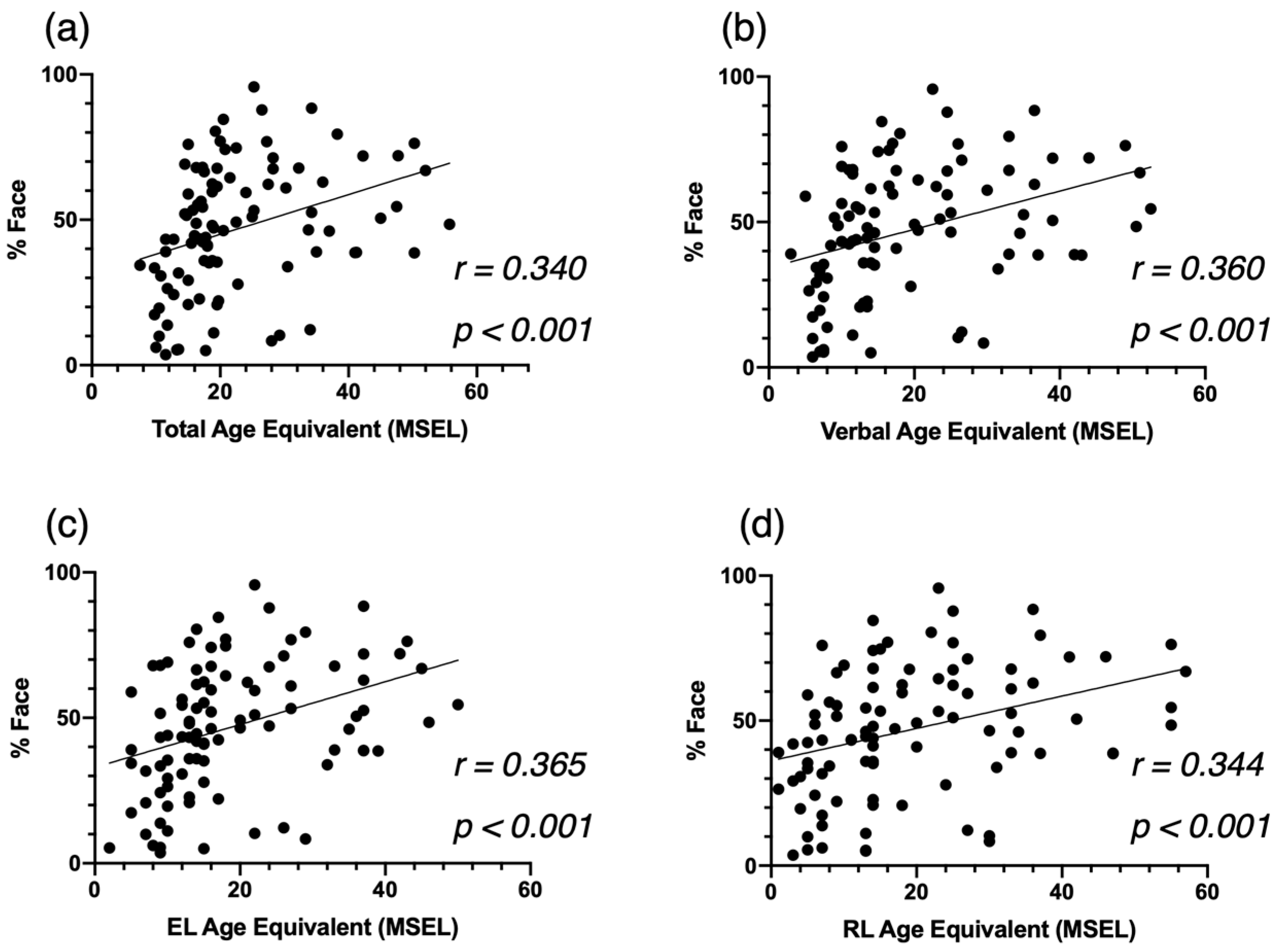
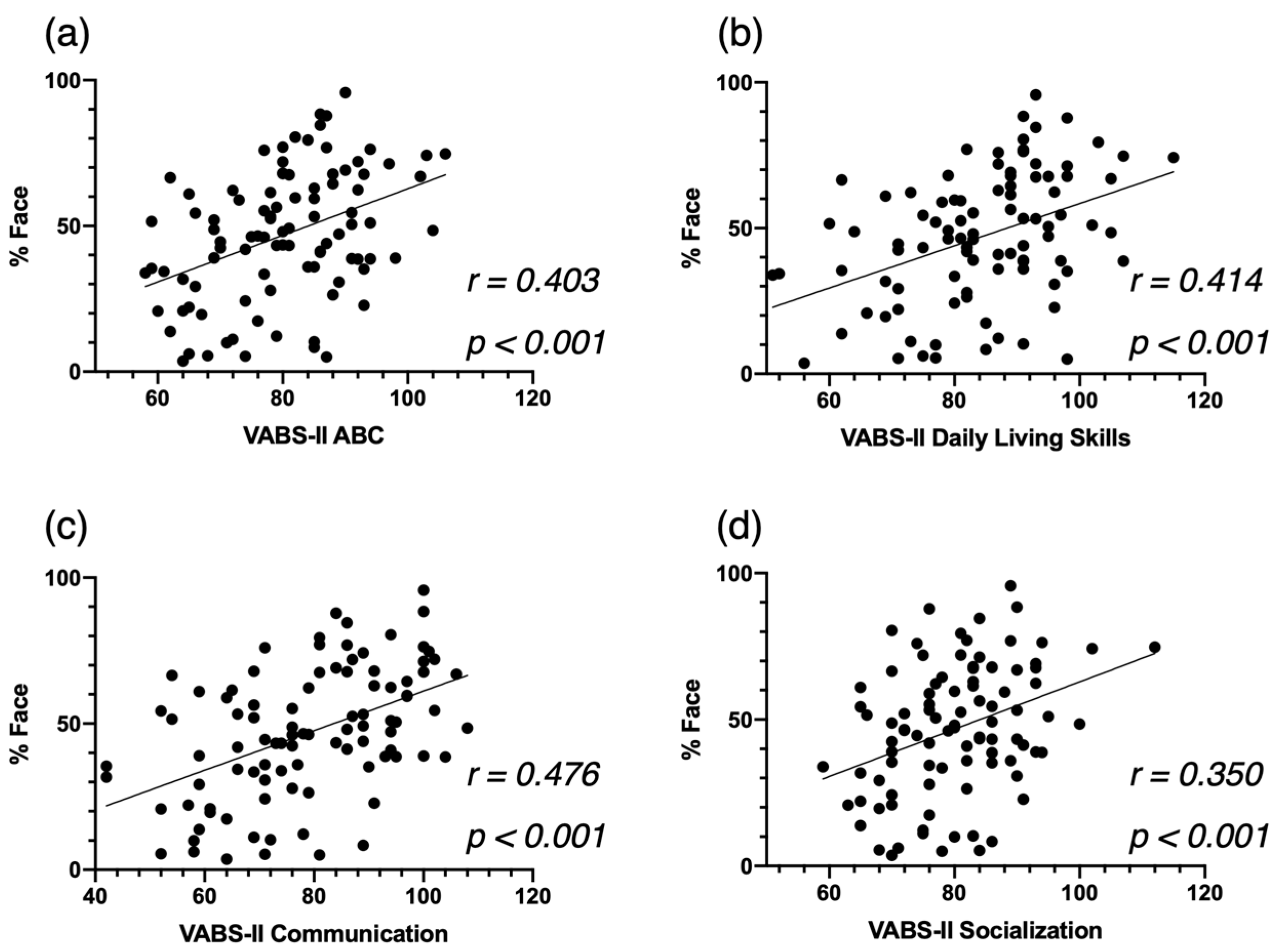
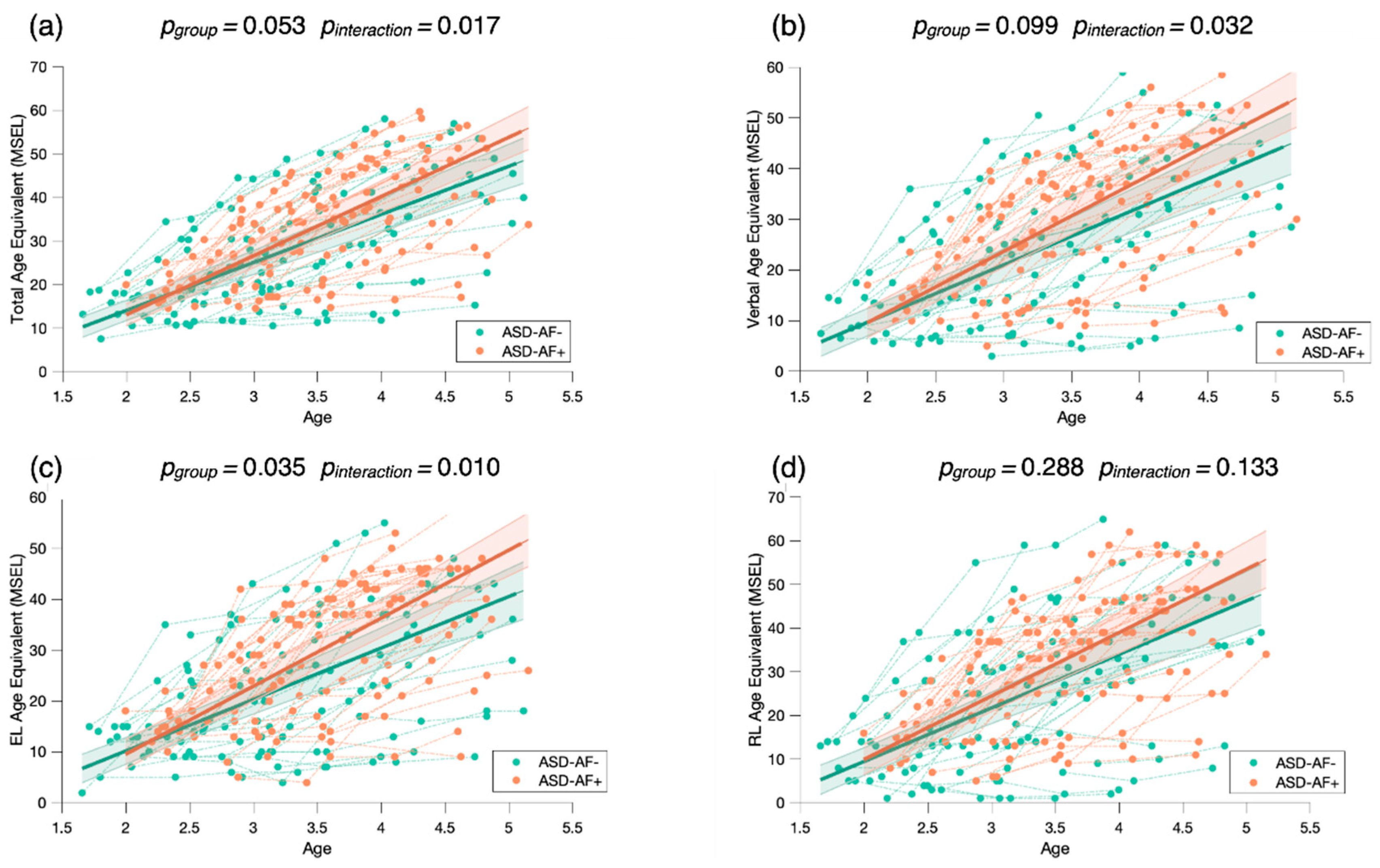
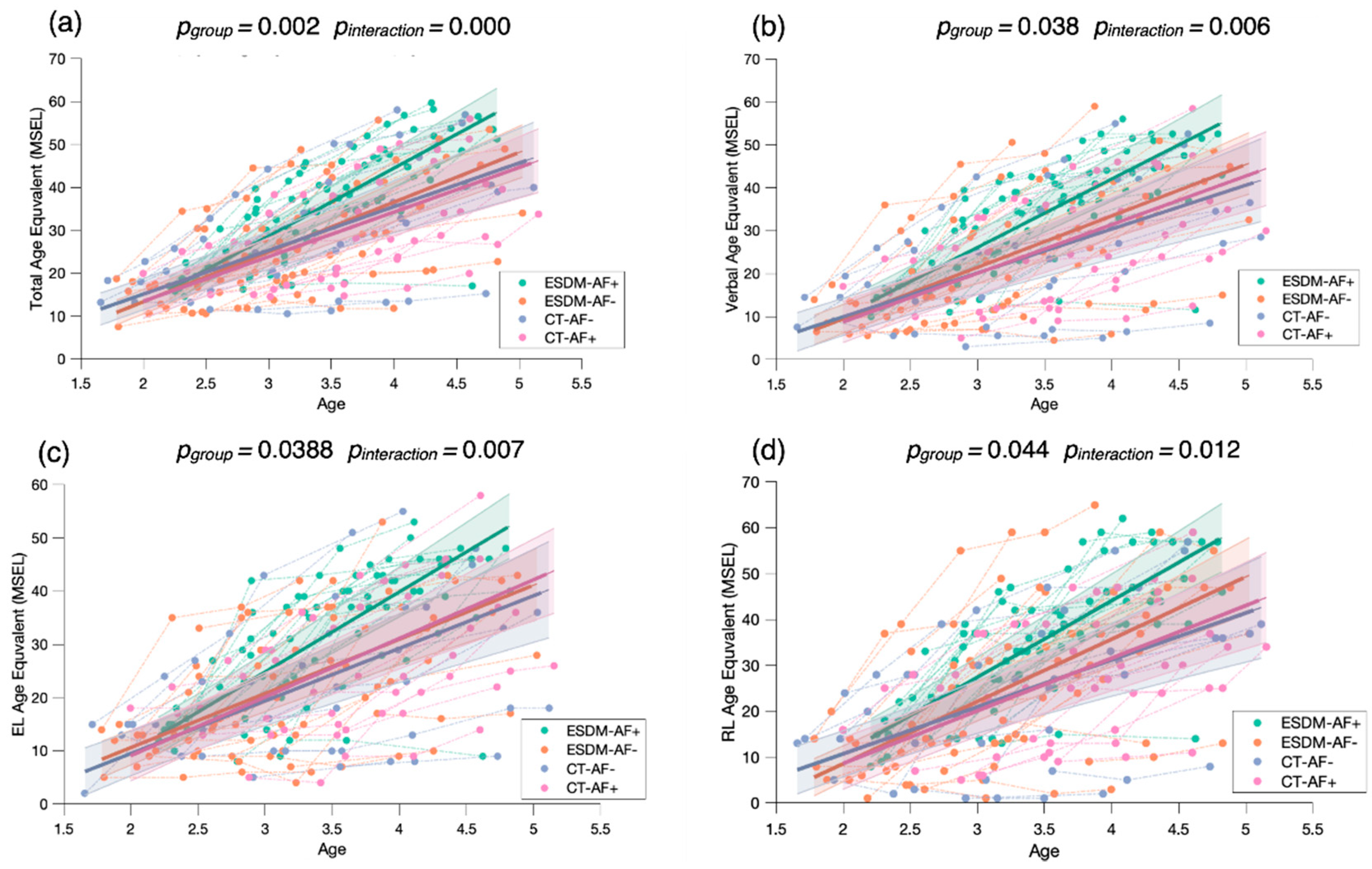
| Cross-Sectional Sample | Longitudinal Sample | |||||||
|---|---|---|---|---|---|---|---|---|
| ASD | TD | p | ESDM AF+ 4 | ESDM AF- 5 | CT AF+ 6 | CT AF- 7 | p | |
| N | 95 | 16 | 25 | 26 | 16 | 14 | ||
| Sex | 14 F | 4 F | 0.290 | 2 F | 4 F | 4 F | 1 F | 0.552 |
| Age (M ± SD) | 2.81 ± 0.65 | 2.49 ± 0.82 | 0.096 | 2.83 ± 0.48 | 2.68 ± 0.68 | 3.04 ± 0.55 | 2.62 ± 0.67 | 0.189 |
| ADOS-2 1 Total | 7.42 ± 1.81 | 1.25 ± 0.58 | <0.001 | 6.92 ± 1.71 | 7.88 ± 1.70 | 7.25 ± 1.73 | 7.64 ± 2.24 | 0.273 |
| ADOS-2 SA | 6.33 ± 2.02 | 1.25 ± 0.58 | <0.001 | 5.80 ± 1.71 | 7.08 ± 1.98 | 5.56 ± 1.93 | 6.50 ± 2.07 | 0.042 |
| ADOS-2 RRB | 8.74 ± 1.63 | 2.19 ± 2.17 | <0.001 | 8.80 ± 1.29 | 8.31 ± 1.81 | 9.38 ± 1.09 | 8.71 ± 2.30 | 0.248 |
| MSEL 2 Total AE 3 | 22.18 ± 11 | 35.4 ± 13 | <0.001 | 24.1 ± 9.87 | 19.9 ± 9.50 | 24 ± 9.13 | 21.1 ± 11.1 | 0.384 |
| MSEL Verbal AE | 19.1 ± 12.2 | 33.9 ± 14.1 | <0.001 | 21 ± 10.9 | 16.2 ± 10.3 | 20.2 ± 11.1 | 15 ± 10.7 | 0.230 |
Publisher’s Note: MDPI stays neutral with regard to jurisdictional claims in published maps and institutional affiliations. |
© 2021 by the authors. Licensee MDPI, Basel, Switzerland. This article is an open access article distributed under the terms and conditions of the Creative Commons Attribution (CC BY) license (https://creativecommons.org/licenses/by/4.0/).
Share and Cite
Latrèche, K.; Kojovic, N.; Franchini, M.; Schaer, M. Attention to Face as a Predictor of Developmental Change and Treatment Outcome in Young Children with Autism Spectrum Disorder. Biomedicines 2021, 9, 942. https://doi.org/10.3390/biomedicines9080942
Latrèche K, Kojovic N, Franchini M, Schaer M. Attention to Face as a Predictor of Developmental Change and Treatment Outcome in Young Children with Autism Spectrum Disorder. Biomedicines. 2021; 9(8):942. https://doi.org/10.3390/biomedicines9080942
Chicago/Turabian StyleLatrèche, Kenza, Nada Kojovic, Martina Franchini, and Marie Schaer. 2021. "Attention to Face as a Predictor of Developmental Change and Treatment Outcome in Young Children with Autism Spectrum Disorder" Biomedicines 9, no. 8: 942. https://doi.org/10.3390/biomedicines9080942
APA StyleLatrèche, K., Kojovic, N., Franchini, M., & Schaer, M. (2021). Attention to Face as a Predictor of Developmental Change and Treatment Outcome in Young Children with Autism Spectrum Disorder. Biomedicines, 9(8), 942. https://doi.org/10.3390/biomedicines9080942






